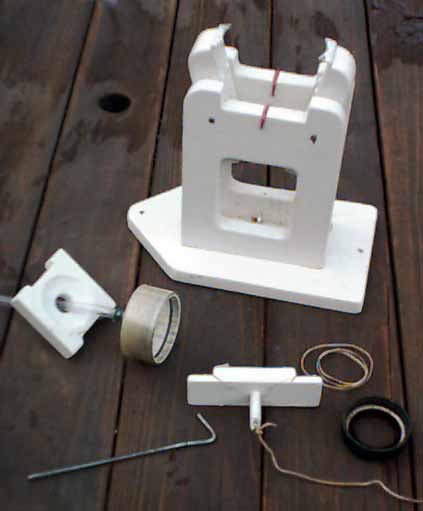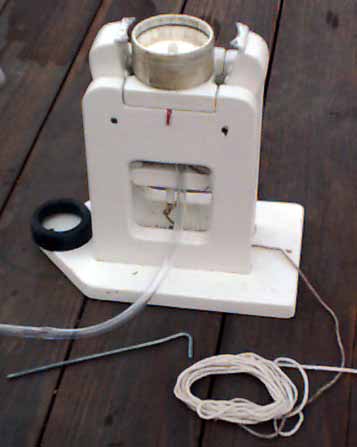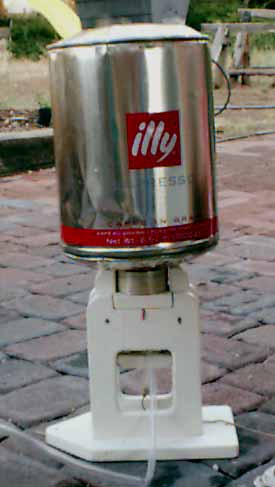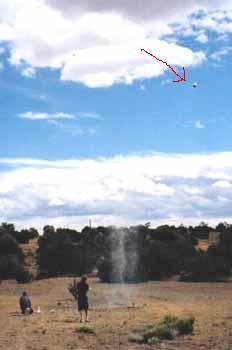the Illy launcher
That's why they call it espresso!
 Having been spoiled by the fabulous coffee they serve at CERN,
we have run espresso
machines here at the lab to satisfy our coffee cravings. We get our beans
straight from Italy,
and it comes in 3 kg cans. These are pressurized, and BIG (8.5" diameter and 12" high,
without the cap). These cans beg to be launched.
Having been spoiled by the fabulous coffee they serve at CERN,
we have run espresso
machines here at the lab to satisfy our coffee cravings. We get our beans
straight from Italy,
and it comes in 3 kg cans. These are pressurized, and BIG (8.5" diameter and 12" high,
without the cap). These cans beg to be launched.
Initially I epoxied the tops of standard small water bottles to the big black screw-on caps.
This way I could
use my standard launcher.
(tumbler- or hinge- type).
However the enormous weight on top of the small nozzle meant that
on launch, the can
would slowly rise into the air, hissing and spitting, and because of the slow speed, the
trajectory was extremely unpredictable. One time, the can rose about five feet, turned 90 degrees
and went horizontally for about 100 meters, luckily away from the crowd. Also it takes
forever to pump up so we didn't do it too often.
Anyway, last summer (2003), the kids and I were playing with the big can on the bunny slope
of the Taos ski area,
and after waiting till there were no people in the immediate vicinity, we filled it
with a large amount of water from the Rio Hondo, and I started pumping. All of a sudden, at
about 50 psi, the thing took off unexpectedly, straight up, and as high as I have ever launced
anything.
Turns out, the epoxy had failed, and the nozzle size was now about 5 cm. Spectacular! On landing,
the can narrowly missed making a dent in the roof of a building.
Of course, this had to be repeated, and I built a
tumbler-type launcher for the cans:

>>>
This is the basic tumbler-type launcher, partially disassembled. You can see the base plate
with 2 uprights. The tumbler arms swing in between the uprights.
On the table you can see the T-piece. This one goes up between the bottoms of the tumbler arms.
It is pulled up with rubber bands which hook onto the pink (coathanger) hooks that are visible
hooked over the top of the uprights. When the T-piece is up, it prevents the top of the tumblers
from spreading, thereby holding the can or bottle in place. The string is for pulling the
T-piece down for launch. The string goes through an eyelet which you can just see screwed into
the bottom plate between the uprights.
The tentpeg is for pegging the base into the ground. Alternatively, you can place the launcher
on a bigger piece of scrap (ply)wood, and use one or two screws through the holes you see
in the base.
On the left is a slightly modified 2.5" pipe cap. It has a nylon hose barb glued in the
bottom, so you can attach a 1/4" hose. There is a groove for an O-ring, which makes the seal
with the coffee-can's cap (black object on the right). The squarish block is shaped to support
the pipe cap.
|

>>>
This is the launcher assembled and ready for the can. The jaws of the tumblers are held
open by another rubber band around the bottom of the tumblers. You can see the support
block and the pipe cap in place. The launching string is threaded out through the eyelet.
The cap is on the left; The opening in the cap is about 1.75" (4.5cm) in diameter.
|

>>>
The black cap is screwed onto the can, and inserted into the pipe cap. Then you push the
tumbler jaws over the cap, and the T-piece snaps up into place between the bottoms of the
tumblers.
Ready for pumping, and then launch!
|
 Click here
for a bigger version
Click here
for a bigger version
|
Last update 1 September 2003 - HvH
back
 Having been spoiled by the fabulous coffee they serve at CERN,
we have run espresso
machines here at the lab to satisfy our coffee cravings. We get our beans
straight from Italy,
and it comes in 3 kg cans. These are pressurized, and BIG (8.5" diameter and 12" high,
without the cap). These cans beg to be launched.
Having been spoiled by the fabulous coffee they serve at CERN,
we have run espresso
machines here at the lab to satisfy our coffee cravings. We get our beans
straight from Italy,
and it comes in 3 kg cans. These are pressurized, and BIG (8.5" diameter and 12" high,
without the cap). These cans beg to be launched.



